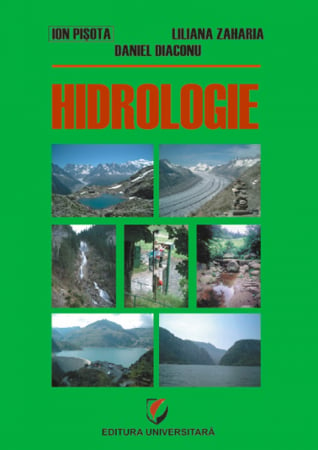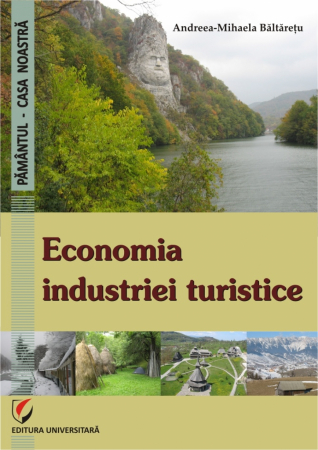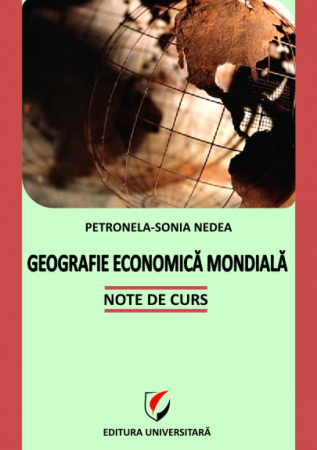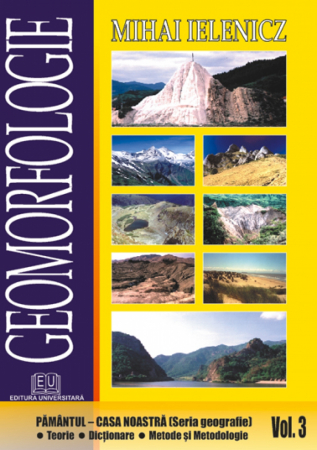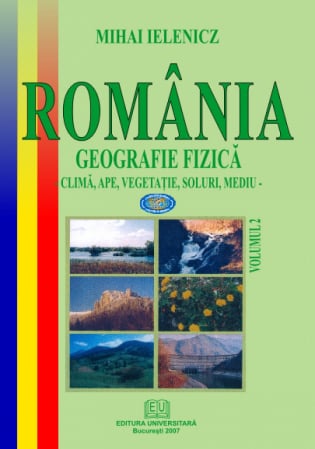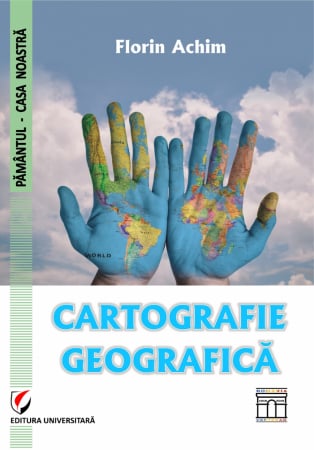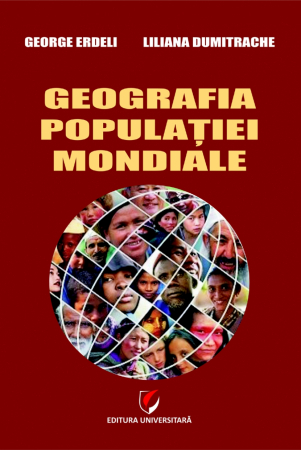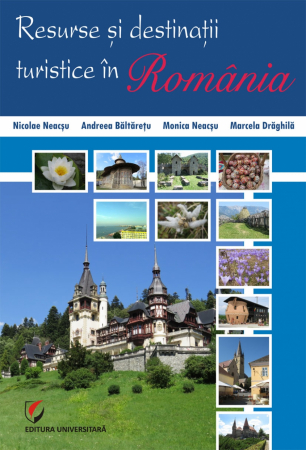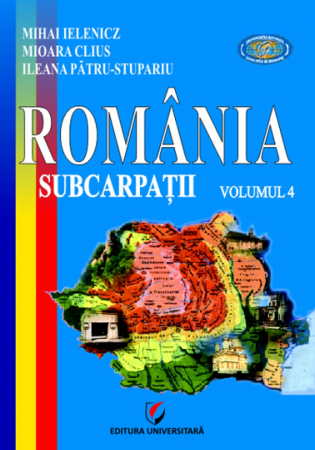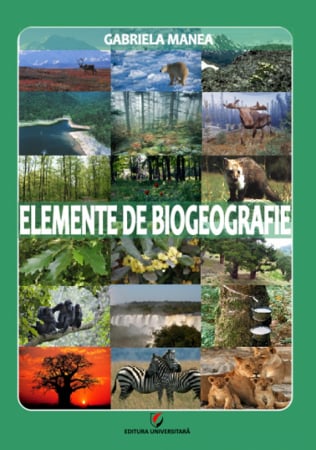Manuscript proposals: [email protected] / 0745 204 115 //// Tracking orders Individuals / Sales: 0745 200 357 / Orders Legal entities: 0721 722 783
ISBN: 978-973-749-478-8
Publisher year: 2008
Edition: I
Pages: 342
Publisher: Editura Universitară
Author: Mihai Ielenicz, Iulian Sandulache
Product Code:
9789737494788
Do you need help?
0745 200 357
- Description
- Download (1)
- Authors
- Content
- More details
- Reviews (0)
Within the hills and plateaus there are important subsoil resources to which are connected many industrial branches, some with an essential role in the national economy (natural gas, oil, lignite, etc.), a varied agriculture is practiced, a series of early developed economic activities that have determined not only the skilled labor force, but also certain specializations, there is a rich fund of tourist reserves that ensure, but especially will determine the assertion of a prosperous economy with this specific.
Here are some of the attributes that formed the basis of an intense geographical research activity materialized in a very large number of articles, studies, monographs, books, etc. If in the interwar period some orientations were made, especially in the research of relief and settlements, later the study of different units taken as the object of a doctoral thesis made possible not only the increase of the number of works, but especially the diversification of problems and fields of study. . The teams of geographic researchers and teachers from the universities of Bucharest, Iasi, Cluj Napoca and from the Geographical Institute had a special role. Within them, apart from the doctoral theses, complex geographical studies with regional character, detailed works on some geographical components, cartographic representations materialized in atlases, etc. were carried out.
As a result, at present, there is a rich and diverse informational fund that has been the basis for writing geographical syntheses and at the level of large units of hills and plateaus. They contain a wealth of information and issues regarding all components of the geographic system. Here is one of the reasons that makes writing such a course quite difficult. But its realization is necessary for other reasons. These must first represent a summum of problems that define the geographical structure of each unit, in which to be found, in addition to the basic features and correlations that are established between components and elements. Secondly, the most important opinions that have been imposed on certain issues, as well as the controversial or unexplained ideas, must be revealed here. Finally, their rendering must be done taking into account those to whom they are addressed.
So, the course must represent both a "training" basis, a qualification, but also an opening one for geographical research. In this sense, this work was sought to be done, which is addressed mainly to geography students, but also to teachers and all those interested in knowing the geographical realities of Romania. It was conceived in two volumes (Plateau and hills - volume 3; Subcarpathians - volume 4) because, on the one hand, the informational volume is particularly rich and on the other, due to the fact that between the Subcarpathians and the other units of hills and plateaus there are important differences in composition, structure, genesis, evolution, interference between natural factors and anthropogenic pressure, which are reflected directly in specific landscapes. At the base was an older work that was updated and supplemented with new ideas.
Here are some of the attributes that formed the basis of an intense geographical research activity materialized in a very large number of articles, studies, monographs, books, etc. If in the interwar period some orientations were made, especially in the research of relief and settlements, later the study of different units taken as the object of a doctoral thesis made possible not only the increase of the number of works, but especially the diversification of problems and fields of study. . The teams of geographic researchers and teachers from the universities of Bucharest, Iasi, Cluj Napoca and from the Geographical Institute had a special role. Within them, apart from the doctoral theses, complex geographical studies with regional character, detailed works on some geographical components, cartographic representations materialized in atlases, etc. were carried out.
As a result, at present, there is a rich and diverse informational fund that has been the basis for writing geographical syntheses and at the level of large units of hills and plateaus. They contain a wealth of information and issues regarding all components of the geographic system. Here is one of the reasons that makes writing such a course quite difficult. But its realization is necessary for other reasons. These must first represent a summum of problems that define the geographical structure of each unit, in which to be found, in addition to the basic features and correlations that are established between components and elements. Secondly, the most important opinions that have been imposed on certain issues, as well as the controversial or unexplained ideas, must be revealed here. Finally, their rendering must be done taking into account those to whom they are addressed.
So, the course must represent both a "training" basis, a qualification, but also an opening one for geographical research. In this sense, this work was sought to be done, which is addressed mainly to geography students, but also to teachers and all those interested in knowing the geographical realities of Romania. It was conceived in two volumes (Plateau and hills - volume 3; Subcarpathians - volume 4) because, on the one hand, the informational volume is particularly rich and on the other, due to the fact that between the Subcarpathians and the other units of hills and plateaus there are important differences in composition, structure, genesis, evolution, interference between natural factors and anthropogenic pressure, which are reflected directly in specific landscapes. At the base was an older work that was updated and supplemented with new ideas.
-
Romania. Plateaus and Hills - vol. lII
Download
MIHAI IELENICZ
Prof. univ. dr., graduated from the Faculty of Geology-Geography in 1964 where he continued his activity going through all the steps of the university hierarchy. Doctor in Geography since 1978 with the work "Mountains from the Buzau basin - study of geomorphology", published in the Academy Publishing House in 1984. He won the Academy Award in 1975 for the work "Relief of Romania" and in 1985 for the work "Encyclopedia of Romania", as well as the title of Doctor Honoris Causa of Stefan cel Mare University - Suceava; He has been awarded over 25 honorary diplomas, excellence and medals by various teaching and scientific institutions in the country and abroad. Vice-Dean and Dean of the Faculty of Geography since 1992 and until now, Director of the Geographical Resort Orsova, Co-director of the "Center for Research on Land Degradation and Geomorphological Dynamics" Member of the Faculty Council and University Senate since 1992, Chairman of the Committee National Program for Pre-University Education (since 1996), CNATDC member, CNEAA, CNCSIS expert, training in the country and abroad (UK, Belgium, Turkey), President of the Geography School Olympics (since 1996), President of the Geography Society ( since 2003), Vice President of the National Geography Committee (since 2000), Vice President of the Geomorphology Association (since 2002), PhD supervisor (since 1993), member of the editorial boards of numerous specialized journals, etc. He wrote alone and in collaboration over 210 scientific papers, participated in 62 research contracts (18 as director), 38 scientific books: "General Geomorphology" 1976, 2002, "Relief of Romania" 1975, "Hills and Plateau of Romania ”1999,„ Dictionar fizico-geografic ”1999,„ Geografia generala ”2001,„ Romania Geography and Tourism ”2001,„ Europa Enciclopedie Geografica ”2002,„ Subcarpatii Romaniei ”2003,„ Romania - Geografie Fizica ”2004,“ Geografie fizica generala . The bases of physical geography ”2005“ Subcarpathians of Romania ”2005,“ Geomorphology ”2007, 2010,“ Romania. Physical geography. Climate, Waters, Vegetation, Soils ”2007,“ Romania. Plateau and hills ”2008,“ Dictionary of geomorphology ”2009,“ General physical geography with elements of cosmology ”2009,“ Romania - Tourist potential ”2009, and numerous popularization books, maps, etc.
IULIAN SANDULACHE
He graduated from the Faculty of Geography, University of Bucharest in 1996, during which he completed the stages of preparator (1996-1999), assistant (1999-2006) and until now, lecturer.
He has been a doctor in Geography since 2005 with the thesis "Bistricioara river basin - geomorphological study".
He is a member of the Association of Romanian Geomorphologists.
He elaborated and published, individually or in collaboration, books, specialized articles and geographical popularization.
He has participated in numerous symposia and national and international scientific congresses (12th Italian-Romanian-Franco-Belgian Geomorphology Congress, Savona, 2007 etc.)
His basic concerns are in the fields of geomorphology, regional geography of Romania and photographic techniques applied in geography.
Prof. univ. dr., graduated from the Faculty of Geology-Geography in 1964 where he continued his activity going through all the steps of the university hierarchy. Doctor in Geography since 1978 with the work "Mountains from the Buzau basin - study of geomorphology", published in the Academy Publishing House in 1984. He won the Academy Award in 1975 for the work "Relief of Romania" and in 1985 for the work "Encyclopedia of Romania", as well as the title of Doctor Honoris Causa of Stefan cel Mare University - Suceava; He has been awarded over 25 honorary diplomas, excellence and medals by various teaching and scientific institutions in the country and abroad. Vice-Dean and Dean of the Faculty of Geography since 1992 and until now, Director of the Geographical Resort Orsova, Co-director of the "Center for Research on Land Degradation and Geomorphological Dynamics" Member of the Faculty Council and University Senate since 1992, Chairman of the Committee National Program for Pre-University Education (since 1996), CNATDC member, CNEAA, CNCSIS expert, training in the country and abroad (UK, Belgium, Turkey), President of the Geography School Olympics (since 1996), President of the Geography Society ( since 2003), Vice President of the National Geography Committee (since 2000), Vice President of the Geomorphology Association (since 2002), PhD supervisor (since 1993), member of the editorial boards of numerous specialized journals, etc. He wrote alone and in collaboration over 210 scientific papers, participated in 62 research contracts (18 as director), 38 scientific books: "General Geomorphology" 1976, 2002, "Relief of Romania" 1975, "Hills and Plateau of Romania ”1999,„ Dictionar fizico-geografic ”1999,„ Geografia generala ”2001,„ Romania Geography and Tourism ”2001,„ Europa Enciclopedie Geografica ”2002,„ Subcarpatii Romaniei ”2003,„ Romania - Geografie Fizica ”2004,“ Geografie fizica generala . The bases of physical geography ”2005“ Subcarpathians of Romania ”2005,“ Geomorphology ”2007, 2010,“ Romania. Physical geography. Climate, Waters, Vegetation, Soils ”2007,“ Romania. Plateau and hills ”2008,“ Dictionary of geomorphology ”2009,“ General physical geography with elements of cosmology ”2009,“ Romania - Tourist potential ”2009, and numerous popularization books, maps, etc.
IULIAN SANDULACHE
He graduated from the Faculty of Geography, University of Bucharest in 1996, during which he completed the stages of preparator (1996-1999), assistant (1999-2006) and until now, lecturer.
He has been a doctor in Geography since 2005 with the thesis "Bistricioara river basin - geomorphological study".
He is a member of the Association of Romanian Geomorphologists.
He elaborated and published, individually or in collaboration, books, specialized articles and geographical popularization.
He has participated in numerous symposia and national and international scientific congresses (12th Italian-Romanian-Franco-Belgian Geomorphology Congress, Savona, 2007 etc.)
His basic concerns are in the fields of geomorphology, regional geography of Romania and photographic techniques applied in geography.
THE REPORT OF FLATS - HALLS, THEIR DISTRIBUTION IN ROMANIA / 18
1. The plateaus - distinct geographical units / 18
2. The hills form the largest geographical units with medium altitude / 21
3. Distribution of plateaus and hills in Romania / 24
MEHEDINTI FLAT / 32
GEOGRAPHICAL POSITION AND LIMITS / 32
PHYSICAL-GEOGRAPHICAL FRAMEWORK / 33
1. GEOLOGICAL COMPOSITION AND PALEOGEOGRAPHIC EVOLUTION / 33
2. RELIEF / 36
3. CLIMATE / 38
4. APELE / 38
5. SOILS, VEGETATION AND ANIMALS / 40
MOLDOVA FLAT / 46
GEOGRAPHICAL LOCATION AND BOUNDARIES / 46
1. GEOLOGICAL COMPOSITION AND PALEOGEOGRAPHIC EVOLUTION / 47
2. RELIEF / 48
3. CLIMATE / 56
4. APELE / 58
5. VEGETATION AND FAUNA / 62
6. SOILS / 65
POPULATION AND SETTLEMENTS / 67
1. HISTORICAL GEOGRAPHY CONSIDERATIONS / 67
2. DEMOGRAPHIC CHARACTERISTICS / 69
3. SETTLEMENT CHARACTERISTICS / 72
ECONOMIC ACTIVITIES / 73
1. GENERAL CHARACTERISTICS / 73
2. INDUSTRY / 76
3. AGRICULTURE / 79
4. WAYS OF COMMUNICATION AND TRANSPORT / 79
5. TOURIST POTENTIAL / 80
GEOGRAPHICAL SUBUNITIES / 81
1. THE FLOOR OF SUCEVA / 81
2. MOLDOVAN PLAIN (LOWER FLAT OF JIJIA) / 87
3. THE FLAT FLOOR / 89
4. COLOR MOLDOVA SIRET / 92
GETIC FLAT / 106
GEOGRAPHICAL SETTLEMENT AND LIMITS / 106
PHYSICAL-GEOGRAPHICAL FRAMEWORK / 107
1. GEOLOGICAL COMPOSITION AND PALEOGRAPHICAL EVOLUTION / 107
2. RELIEF / 109
3. CLIMATE / 113
4. APELE / 115
5. VEGETATION AND ANIMALS / 116
6. SOILS / 119
POPULATION AND SETTLEMENTS / 119
1. HISTORICAL GEOGRAPHY CONSIDERATIONS / 119
2. DEMOGRAPHIC CHARACTERISTICS / 120
3. SETTLEMENT CHARACTERISTICS / 123
ECONOMIC ACTIVITIES / 123
1. GENERAL CHARACTERISTICS / 124
2. AGRICULTURE / 125
3. INDUSTRY / 126
4. WAYS OF COMMUNICATION AND TRANSPORT / 127
5. TOURIST POTENTIAL / 128
GEOGRAPHICAL SUBUNITIES / 128
1. THE FLAT STREAM / 128
2. THE GROUPS OF JIU / 131
3. THE FLAT (HALLS) OF OLTET / 132
5. THE DEALS (CRANES) OF ARGES / 135
DOBROGEI FLAT / 145
GEOGRAPHICAL SETTLEMENT AND LIMITS / 145
1. GEOLOGICAL COMPOSITION AND PALEO-GEOGRAPHICAL EVOLUTION / 145
2. RELIEF / 149
3. CLIMATE / 155
4. APELE / 157
5. VEGETATION AND FAUNA / 160
6. SOILS / 165
POPULATION AND SETTLEMENTS / 166
1. HISTORICAL GEOGRAPHY CONSIDERATIONS / 166
2. DEMOGRAPHIC CHARACTERISTICS / 169
2.4. NATURAL MOVEMENT / 170
3. SETTLEMENT CHARACTERISTICS / 173
ECONOMIC ACTIVITIES / 177
2. AGRICULTURE / 181
3. WAYS OF COMMUNICATION AND TRANSPORT / 185
4. TOURIST POTENTIAL / 187
GEOGRAPHICAL SUBUNITIES / 187
NORTHERN DOBROGEA / 188
CENTRAL DOBROGEA FLAT / 190
SOUTHERN DOBROGEA / 192
DEALS OF TRANSYLVANIA / 208
(HILL HILL DEPRESSION OF TRANSYLVANIA) / 208
GEOGRAPHICAL SETTLEMENT AND LIMITS / 208
PHYSICAL-GEOGRAPHICAL FRAMEWORK / 211
1. GEOLOGICAL COMPOSITION AND PALEOGEOGRAPHIC EVOLUTION / 211
2. RELIEF / 214
3. CLIMATE / 223
4. APELE / 226
5. VEGETATION AND FAUNA / 230
6. SOILS / 235
POPULATION AND SETTLEMENTS / 237
1. CHARACTERISTICS OF HISTORICAL GEOGRAPHY / 237
2. DEMOGRAPHIC CHARACTERISTICS / 238
3. SETTLEMENT CHARACTERISTICS / 244
ECONOMIC ACTIVITIES / 247
1. GENERAL CHARACTERISTICS / 247
2. INDUSTRY / 247
3. AGRICULTURE / 254
4. WAYS OF COMMUNICATION AND TRANSPORT / 258
5. TOURIST POTENTIAL / 261
GEOGRAPHICAL UNITS AND SUBUNITIES / 262
I. PERITRANSILVAN DEALS AND DEPRESSIONS (PERIMONTANEOUS, CIRCUMTRANSILVANE) / 263
SOMESAN FLAT / 274
HILL HILL OF TRANSYLVANIA (MURESANO - SOMESENE DEALS) / 278
THE FLAT FLAT / 282
BANATO - SOMESENE DEALS (WESTERN DEALS) / 304
GEOGRAPHICAL LOCATION AND LIMITS / 304
PHYSICAL-GEOGRAPHICAL FRAMEWORK / 305
1. GEOLOGICAL COMPOSITION AND LIMITS / 305
2. RELIEF / 306
3. CLIMATE / 307
4. APELE / 308
5. VEGETATION, ANIMALS AND SOILS / 309
POPULATION AND SETTLEMENTS / 310
1. HISTORICAL GEOGRAPHY CONSIDERATIONS / 310
2. DEMOGRAPHIC CHARACTERISTICS / 311
3. CHARACTERISTICS OF THE SETTLEMENTS / 313
ECONOMIC ACTIVITIES / 316
1. GENERAL CHARACTERISTICS / 316
2. AGRICULTURE / 316
3. INDUSTRY / 317
4. WAYS OF COMMUNICATION / 318
GEOGRAPHICAL SUBUNITIES / 319
1. BAIA MARE DEPRESSION AND MARAMURESENE DEPRESSION / 319
2. THE DEALS OF SILVANIA / 324
3. CRISIS DEALS / 326
4. BANAT DEALS / 328
1. The plateaus - distinct geographical units / 18
2. The hills form the largest geographical units with medium altitude / 21
3. Distribution of plateaus and hills in Romania / 24
MEHEDINTI FLAT / 32
GEOGRAPHICAL POSITION AND LIMITS / 32
PHYSICAL-GEOGRAPHICAL FRAMEWORK / 33
1. GEOLOGICAL COMPOSITION AND PALEOGEOGRAPHIC EVOLUTION / 33
2. RELIEF / 36
3. CLIMATE / 38
4. APELE / 38
5. SOILS, VEGETATION AND ANIMALS / 40
MOLDOVA FLAT / 46
GEOGRAPHICAL LOCATION AND BOUNDARIES / 46
1. GEOLOGICAL COMPOSITION AND PALEOGEOGRAPHIC EVOLUTION / 47
2. RELIEF / 48
3. CLIMATE / 56
4. APELE / 58
5. VEGETATION AND FAUNA / 62
6. SOILS / 65
POPULATION AND SETTLEMENTS / 67
1. HISTORICAL GEOGRAPHY CONSIDERATIONS / 67
2. DEMOGRAPHIC CHARACTERISTICS / 69
3. SETTLEMENT CHARACTERISTICS / 72
ECONOMIC ACTIVITIES / 73
1. GENERAL CHARACTERISTICS / 73
2. INDUSTRY / 76
3. AGRICULTURE / 79
4. WAYS OF COMMUNICATION AND TRANSPORT / 79
5. TOURIST POTENTIAL / 80
GEOGRAPHICAL SUBUNITIES / 81
1. THE FLOOR OF SUCEVA / 81
2. MOLDOVAN PLAIN (LOWER FLAT OF JIJIA) / 87
3. THE FLAT FLOOR / 89
4. COLOR MOLDOVA SIRET / 92
GETIC FLAT / 106
GEOGRAPHICAL SETTLEMENT AND LIMITS / 106
PHYSICAL-GEOGRAPHICAL FRAMEWORK / 107
1. GEOLOGICAL COMPOSITION AND PALEOGRAPHICAL EVOLUTION / 107
2. RELIEF / 109
3. CLIMATE / 113
4. APELE / 115
5. VEGETATION AND ANIMALS / 116
6. SOILS / 119
POPULATION AND SETTLEMENTS / 119
1. HISTORICAL GEOGRAPHY CONSIDERATIONS / 119
2. DEMOGRAPHIC CHARACTERISTICS / 120
3. SETTLEMENT CHARACTERISTICS / 123
ECONOMIC ACTIVITIES / 123
1. GENERAL CHARACTERISTICS / 124
2. AGRICULTURE / 125
3. INDUSTRY / 126
4. WAYS OF COMMUNICATION AND TRANSPORT / 127
5. TOURIST POTENTIAL / 128
GEOGRAPHICAL SUBUNITIES / 128
1. THE FLAT STREAM / 128
2. THE GROUPS OF JIU / 131
3. THE FLAT (HALLS) OF OLTET / 132
5. THE DEALS (CRANES) OF ARGES / 135
DOBROGEI FLAT / 145
GEOGRAPHICAL SETTLEMENT AND LIMITS / 145
1. GEOLOGICAL COMPOSITION AND PALEO-GEOGRAPHICAL EVOLUTION / 145
2. RELIEF / 149
3. CLIMATE / 155
4. APELE / 157
5. VEGETATION AND FAUNA / 160
6. SOILS / 165
POPULATION AND SETTLEMENTS / 166
1. HISTORICAL GEOGRAPHY CONSIDERATIONS / 166
2. DEMOGRAPHIC CHARACTERISTICS / 169
2.4. NATURAL MOVEMENT / 170
3. SETTLEMENT CHARACTERISTICS / 173
ECONOMIC ACTIVITIES / 177
2. AGRICULTURE / 181
3. WAYS OF COMMUNICATION AND TRANSPORT / 185
4. TOURIST POTENTIAL / 187
GEOGRAPHICAL SUBUNITIES / 187
NORTHERN DOBROGEA / 188
CENTRAL DOBROGEA FLAT / 190
SOUTHERN DOBROGEA / 192
DEALS OF TRANSYLVANIA / 208
(HILL HILL DEPRESSION OF TRANSYLVANIA) / 208
GEOGRAPHICAL SETTLEMENT AND LIMITS / 208
PHYSICAL-GEOGRAPHICAL FRAMEWORK / 211
1. GEOLOGICAL COMPOSITION AND PALEOGEOGRAPHIC EVOLUTION / 211
2. RELIEF / 214
3. CLIMATE / 223
4. APELE / 226
5. VEGETATION AND FAUNA / 230
6. SOILS / 235
POPULATION AND SETTLEMENTS / 237
1. CHARACTERISTICS OF HISTORICAL GEOGRAPHY / 237
2. DEMOGRAPHIC CHARACTERISTICS / 238
3. SETTLEMENT CHARACTERISTICS / 244
ECONOMIC ACTIVITIES / 247
1. GENERAL CHARACTERISTICS / 247
2. INDUSTRY / 247
3. AGRICULTURE / 254
4. WAYS OF COMMUNICATION AND TRANSPORT / 258
5. TOURIST POTENTIAL / 261
GEOGRAPHICAL UNITS AND SUBUNITIES / 262
I. PERITRANSILVAN DEALS AND DEPRESSIONS (PERIMONTANEOUS, CIRCUMTRANSILVANE) / 263
SOMESAN FLAT / 274
HILL HILL OF TRANSYLVANIA (MURESANO - SOMESENE DEALS) / 278
THE FLAT FLAT / 282
BANATO - SOMESENE DEALS (WESTERN DEALS) / 304
GEOGRAPHICAL LOCATION AND LIMITS / 304
PHYSICAL-GEOGRAPHICAL FRAMEWORK / 305
1. GEOLOGICAL COMPOSITION AND LIMITS / 305
2. RELIEF / 306
3. CLIMATE / 307
4. APELE / 308
5. VEGETATION, ANIMALS AND SOILS / 309
POPULATION AND SETTLEMENTS / 310
1. HISTORICAL GEOGRAPHY CONSIDERATIONS / 310
2. DEMOGRAPHIC CHARACTERISTICS / 311
3. CHARACTERISTICS OF THE SETTLEMENTS / 313
ECONOMIC ACTIVITIES / 316
1. GENERAL CHARACTERISTICS / 316
2. AGRICULTURE / 316
3. INDUSTRY / 317
4. WAYS OF COMMUNICATION / 318
GEOGRAPHICAL SUBUNITIES / 319
1. BAIA MARE DEPRESSION AND MARAMURESENE DEPRESSION / 319
2. THE DEALS OF SILVANIA / 324
3. CRISIS DEALS / 326
4. BANAT DEALS / 328
The regions of hills and plateaus constitute the largest geographical stage on the Romanian territory. By position, they surround the Carpathians while making the transition to the plain units. This situation imposes a fundamental characteristic of them, that of area of natural and socio-economic interference through which the unity and complexity of the Romanian geographical space is ensured.
Their analysis, even general, reveals other aspects that define their personality and place in the structure of the geographical system. Some of them are very old units, which have undergone a much more complex evolution than the Carpathians, which gave materials to newer, neighboring sea basins, but which in turn suffered the influences of tectonic processes that took place within them. Their evolution determined a complex structure with a Paleozoic Precambrian foundation and a thick sedimentary mass resulting from several accumulation cycles. What appears on the surface frequently are Neozoic rocks, but with the predominance of the Pliocene - Quaternary, formations contained in various geological structures, hence a certain relief reflection. If the evolution is lasting, the relief we observe is much more recent. With some exceptions, in most cases it belongs to the Upper Pliocene and Cuternary. In most situations, its realization was closely related to the evolution of the Carpathian chain that was integrating and rising at the same time. They suffered slight rises as a reflection of those in the Carpathians, on them and extended the courses the Carpathian water streams that cut valleys or accumulated foothills, here some formations suffered undulations or even wrinkles imposed by the tectonic processes in the Carpathians. These units take place close to sea level and up to over 1000 m from where the variety of hypsometric conditions, depending on which water erosion has sectioned wide or narrow valley color, sculpted depressions, highlighted petrographic and structural contacts, created rounded, sharp, symmetrical or asymmetrical peaks, imposed a great variety of versatility in shape and inclination. The almost 1000 m of vertical development, but also the position of these units in relation to the Carpathians determined multiple climatic conditions reflected both in the layered arrangement of biopedoclimatic elements and in their local variations, situations that defined a multitude of natural landscapes.
The hills and plateaus of Romania, through the extremely favorable natural conditions for life, constituted and represent the area with the widest development of human settlements, with the largest number of inhabitants. Their position between the Carpathians and the plain, the fact that they are crossed by the color of wide valleys that connect the three units have ensured the complexity of the economic relations between their inhabitants.
Within the hills and plateaus there are important subsoil resources to which are connected many industrial branches, some with an essential role in the national economy (natural gas, oil, lignite, etc.), a varied agriculture is practiced, a series of early developed economic activities that have determined not only the skilled labor force, but also certain specializations, there is a rich fund of tourist reserves that ensure, but especially will determine the assertion of a prosperous economy with this specific.
Here are some of the attributes that formed the basis of an intense geographical research activity materialized in a very large number of articles, studies, monographs, books, etc. If in the interwar period some orientations were made, especially in the research of relief and settlements, later the study of different units taken as the object of a doctoral thesis made possible not only the increase of the number of works, but especially the diversification of problems and fields of study. . The teams of geographic researchers and teachers from the universities of Bucharest, Iasi, Cluj Napoca and from the Geographical Institute had a special role. Within them, apart from the doctoral theses, complex geographical studies with regional character, detailed works on some geographical components, cartographic representations materialized in atlases, etc. were carried out.
As a result, at present, there is a rich and diverse informational fund that has been the basis for writing geographical syntheses and at the level of large units of hills and plateaus. They contain a wealth of information and issues regarding all components of the geographic system. Here is one of the reasons that makes writing such a course quite difficult. But its realization is necessary for other reasons. These must first represent a summum of problems that define the geographical structure of each unit, in which to be found, in addition to the basic features and correlations that are established between components and elements. Secondly, here we must reveal the most important opinions that have been imposed in certain problems, as well as controversial or unexplained ideas. Finally, their rendering must be done taking into account those to whom they are addressed.
So, the course must represent both a "training" basis, a qualification, but also an opening one for geographical research. In this sense, this work was sought to be done, which is addressed mainly to geography students, but also to teachers and all those interested in knowing the geographical realities of Romania. It was conceived in two volumes (Plateau and hills - volume 3; Subcarpathians - volume 4) because, on the one hand, the informational volume is particularly rich and on the other, due to the fact that between the Subcarpathians and the other units of hills and plateaus there are important differences in composition, structure, genesis, evolution, interference between natural factors and anthropogenic pressure, which are reflected directly in specific landscapes. At the base was an older work that was updated and supplemented with new ideas.
Prof. univ. Dr. Mihai IELENICZ
Their analysis, even general, reveals other aspects that define their personality and place in the structure of the geographical system. Some of them are very old units, which have undergone a much more complex evolution than the Carpathians, which gave materials to newer, neighboring sea basins, but which in turn suffered the influences of tectonic processes that took place within them. Their evolution determined a complex structure with a Paleozoic Precambrian foundation and a thick sedimentary mass resulting from several accumulation cycles. What appears on the surface frequently are Neozoic rocks, but with the predominance of the Pliocene - Quaternary, formations contained in various geological structures, hence a certain relief reflection. If the evolution is lasting, the relief we observe is much more recent. With some exceptions, in most cases it belongs to the Upper Pliocene and Cuternary. In most situations, its realization was closely related to the evolution of the Carpathian chain that was integrating and rising at the same time. They suffered slight rises as a reflection of those in the Carpathians, on them and extended the courses the Carpathian water streams that cut valleys or accumulated foothills, here some formations suffered undulations or even wrinkles imposed by the tectonic processes in the Carpathians. These units take place close to sea level and up to over 1000 m from where the variety of hypsometric conditions, depending on which water erosion has sectioned wide or narrow valley color, sculpted depressions, highlighted petrographic and structural contacts, created rounded, sharp, symmetrical or asymmetrical peaks, imposed a great variety of versatility in shape and inclination. The almost 1000 m of vertical development, but also the position of these units in relation to the Carpathians determined multiple climatic conditions reflected both in the layered arrangement of biopedoclimatic elements and in their local variations, situations that defined a multitude of natural landscapes.
The hills and plateaus of Romania, through the extremely favorable natural conditions for life, constituted and represent the area with the widest development of human settlements, with the largest number of inhabitants. Their position between the Carpathians and the plain, the fact that they are crossed by the color of wide valleys that connect the three units have ensured the complexity of the economic relations between their inhabitants.
Within the hills and plateaus there are important subsoil resources to which are connected many industrial branches, some with an essential role in the national economy (natural gas, oil, lignite, etc.), a varied agriculture is practiced, a series of early developed economic activities that have determined not only the skilled labor force, but also certain specializations, there is a rich fund of tourist reserves that ensure, but especially will determine the assertion of a prosperous economy with this specific.
Here are some of the attributes that formed the basis of an intense geographical research activity materialized in a very large number of articles, studies, monographs, books, etc. If in the interwar period some orientations were made, especially in the research of relief and settlements, later the study of different units taken as the object of a doctoral thesis made possible not only the increase of the number of works, but especially the diversification of problems and fields of study. . The teams of geographic researchers and teachers from the universities of Bucharest, Iasi, Cluj Napoca and from the Geographical Institute had a special role. Within them, apart from the doctoral theses, complex geographical studies with regional character, detailed works on some geographical components, cartographic representations materialized in atlases, etc. were carried out.
As a result, at present, there is a rich and diverse informational fund that has been the basis for writing geographical syntheses and at the level of large units of hills and plateaus. They contain a wealth of information and issues regarding all components of the geographic system. Here is one of the reasons that makes writing such a course quite difficult. But its realization is necessary for other reasons. These must first represent a summum of problems that define the geographical structure of each unit, in which to be found, in addition to the basic features and correlations that are established between components and elements. Secondly, here we must reveal the most important opinions that have been imposed in certain problems, as well as controversial or unexplained ideas. Finally, their rendering must be done taking into account those to whom they are addressed.
So, the course must represent both a "training" basis, a qualification, but also an opening one for geographical research. In this sense, this work was sought to be done, which is addressed mainly to geography students, but also to teachers and all those interested in knowing the geographical realities of Romania. It was conceived in two volumes (Plateau and hills - volume 3; Subcarpathians - volume 4) because, on the one hand, the informational volume is particularly rich and on the other, due to the fact that between the Subcarpathians and the other units of hills and plateaus there are important differences in composition, structure, genesis, evolution, interference between natural factors and anthropogenic pressure, which are reflected directly in specific landscapes. At the base was an older work that was updated and supplemented with new ideas.
Prof. univ. Dr. Mihai IELENICZ
If you want to express your opinion about this product you can add a review.
write a review

6359.png)
![Romania. Plateaus and Hills - vol. lII [1] Romania. Plateaus and Hills - vol. lII [1]](https://gomagcdn.ro/domains/editurauniversitara.ro/files/product/large/romania-podisuri-si-dealuri-vol-iii-2694-324389.jpg)
